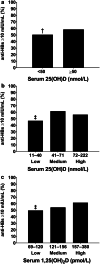Vitamin D and the hepatitis B vaccine response: a prospective cohort study and a randomized, placebo-controlled oral vitamin D3 and simulated sunlight supplementation trial in healthy adults
- PMID: 32390123
- PMCID: PMC7867563
- DOI: 10.1007/s00394-020-02261-w
Vitamin D and the hepatitis B vaccine response: a prospective cohort study and a randomized, placebo-controlled oral vitamin D3 and simulated sunlight supplementation trial in healthy adults
Abstract
Purpose: To determine serum 25(OH)D and 1,25(OH)2D relationship with hepatitis B vaccination (study 1). Then, to investigate the effects on hepatitis B vaccination of achieving vitamin D sufficiency (serum 25(OH)D ≥ 50 nmol/L) by a unique comparison of simulated sunlight and oral vitamin D3 supplementation in wintertime (study 2).
Methods: Study 1 involved 447 adults. In study 2, 3 days after the initial hepatitis B vaccination, 119 men received either placebo, simulated sunlight (1.3 × standard-erythema dose, 3 × /week for 4 weeks and then 1 × /week for 8 weeks) or oral vitamin D3 (1000 IU/day for 4 weeks and 400 IU/day for 8 weeks). We measured hepatitis B vaccination efficacy as percentage of responders with anti-hepatitis B surface antigen immunoglobulin G ≥ 10 mIU/mL.
Results: In study 1, vaccine response was poorer in persons with low vitamin D status (25(OH)D ≤ 40 vs 41-71 nmol/L mean difference [95% confidence interval] - 15% [- 26, - 3%]; 1,25(OH)2D ≤ 120 vs ≥ 157 pmol/L - 12% [- 24%, - 1%]). Vaccine response was also poorer in winter than summer (- 18% [- 31%, - 3%]), when serum 25(OH)D and 1,25(OH)2D were at seasonal nadirs, and 81% of persons had serum 25(OH)D < 50 nmol/L. In study 2, vitamin D supplementation strategies were similarly effective in achieving vitamin D sufficiency from the winter vitamin D nadir in almost all (~ 95%); however, the supplementation beginning 3 days after the initial vaccination did not effect the vaccine response (vitamin D vs placebo 4% [- 21%, 14%]).
Conclusion: Low vitamin D status at initial vaccination was associated with poorer hepatitis B vaccine response (study 1); however, vitamin D supplementation commencing 3 days after vaccination (study 2) did not influence the vaccination response.
Clinical trial registry number: Study 1 NCT02416895; https://clinicaltrials.gov/ct2/show/study/NCT02416895 ; Study 2 NCT03132103; https://clinicaltrials.gov/ct2/show/NCT03132103 .
Keywords: 25-Hydroxyvitamin D; Cholecalciferol; Hepatitis B; UVB; Vaccination; Vitamin D.
Conflict of interest statement
None of the authors report a conflict of interest related to the study.
Figures







Similar articles
-
Influence of Vitamin D Supplementation by Sunlight or Oral D3 on Exercise Performance.Med Sci Sports Exerc. 2018 Dec;50(12):2555-2564. doi: 10.1249/MSS.0000000000001721. Med Sci Sports Exerc. 2018. PMID: 30048414 Free PMC article. Clinical Trial.
-
Vitamin D Supplementation and Sunlight Exposure on Serum Vitamin D Concentrations in 2 Parallel, Double-Blind, Randomized, Placebo-Controlled Trials.J Nutr. 2021 Oct 1;151(10):3137-3150. doi: 10.1093/jn/nxab209. J Nutr. 2021. PMID: 34255034 Clinical Trial.
-
Relative effectiveness of oral 25-hydroxyvitamin D3 and vitamin D3 in raising wintertime serum 25-hydroxyvitamin D in older adults.Am J Clin Nutr. 2012 Jun;95(6):1350-6. doi: 10.3945/ajcn.111.031427. Epub 2012 May 2. Am J Clin Nutr. 2012. PMID: 22552038 Clinical Trial.
-
Serum 25(OH)D response to vitamin D3 supplementation: a meta-regression analysis.Nutrition. 2014 Sep;30(9):975-85. doi: 10.1016/j.nut.2013.12.020. Epub 2014 Jan 10. Nutrition. 2014. PMID: 24993750 Review.
-
Meta-Analysis of European Clinical Trials Characterizing the Healthy-Adult Serum 25-hydroxyvitamin D Response to Vitamin D Supplementation.Nutrients. 2023 Sep 14;15(18):3986. doi: 10.3390/nu15183986. Nutrients. 2023. PMID: 37764770 Free PMC article. Review.
Cited by
-
Correlation Between Vitamin D Status and HBsAg Antibody Levels in Indonesian Adolescents Immunised Against Hepatitis B.Int J Gen Med. 2023 Nov 8;16:5183-5192. doi: 10.2147/IJGM.S434290. eCollection 2023. Int J Gen Med. 2023. PMID: 38021059 Free PMC article.
-
Vitamin D-VDR Novel Anti-Inflammatory Molecules-New Insights into Their Effects on Liver Diseases.Int J Mol Sci. 2022 Jul 30;23(15):8465. doi: 10.3390/ijms23158465. Int J Mol Sci. 2022. PMID: 35955597 Free PMC article. Review.
-
Environmental effects of stratospheric ozone depletion, UV radiation, and interactions with climate change: UNEP Environmental Effects Assessment Panel, Update 2020.Photochem Photobiol Sci. 2021 Jan;20(1):1-67. doi: 10.1007/s43630-020-00001-x. Epub 2021 Jan 20. Photochem Photobiol Sci. 2021. PMID: 33721243 Free PMC article.
-
COVID-19 vaccines in patients with cancer: immunogenicity, efficacy and safety.Nat Rev Clin Oncol. 2022 Jun;19(6):385-401. doi: 10.1038/s41571-022-00610-8. Epub 2022 Mar 11. Nat Rev Clin Oncol. 2022. PMID: 35277694 Free PMC article. Review.
-
Association of hepatitis B vaccine response to vitamin D supplementation and ultraviolet B (UVB) exposure during different time intervals in experimental animals.Immunol Res. 2022 Aug;70(4):537-545. doi: 10.1007/s12026-022-09287-8. Epub 2022 May 19. Immunol Res. 2022. PMID: 35585421 Free PMC article.
References
-
- He CS, Handzlik M, Fraser WD, Muhamad A, Preston H, Richardson A, Gleeson M. Influence of vitamin D status on respiratory infection incidence and immune function during 4 months of winter training in endurance sport athletes. Exerc Immunol Rev. 2013;19:86–101. - PubMed
Publication types
MeSH terms
Substances
Associated data
LinkOut - more resources
Full Text Sources
Medical

